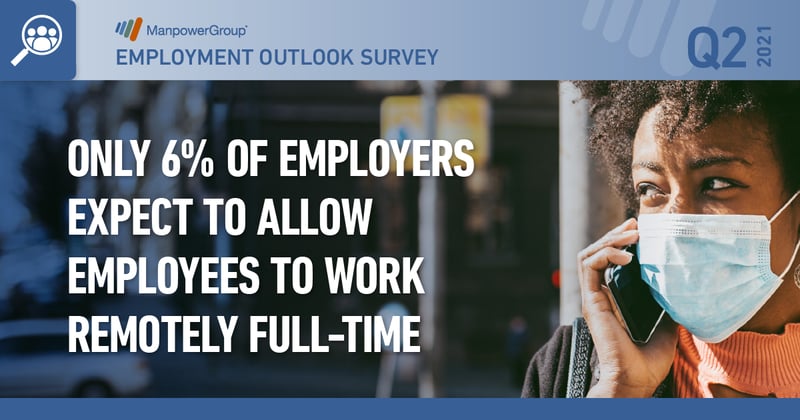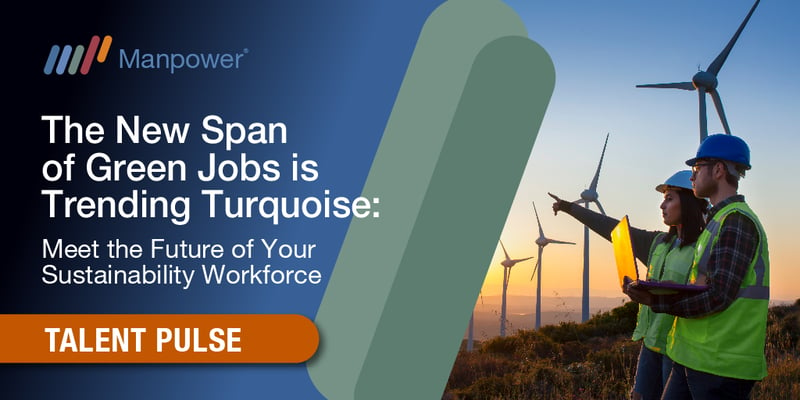The global health, economic and social crisis is driving digital transformation at an unprecedented scale. Organizations need to develop resilience by retooling their workforce and making their people, processes, and technology more flexible while accounting for risk, cost, efficiency and quality.
Here are 5 trends – accelerated by the pandemic - that are shaping the workplace this year and challenging organizations to adjust their talent strategies to attract and retain right-skilled workers.
1. Digitalization is exacerbating skills scarcity
As a result of the pandemic, 38% of companies are accelerating their digitalization and acceleration plans, while 17% have put plans on hold. Companies that are digitizing the most are creating the most jobs: 86% that are automating also plan to increase their headcount.¹
Other factors pushing organizations toward digitalization is the rising sophistication of technology like 5G and the social and economic impacts of the pandemic. Social distancing rules and stay-at-home orders have changed us from “in” people (in-store, in-person) to “on” people (who expect everything online, on-demand, and on time).
Additionally, the rapid growth of new industries, including telemedicine, pharma, ed-tech and self-care are further driving the demand for personalization and on-demand, remote, touch-free and contactless solutions. To deliver on these solutions and meet their business objectives, organizations need talent with the right combination of human and technical skills.
Unfortunately, widespread talent shortages mean workers with these skills are in short supply. The most innovative organizations are bridging the gap between the workforce they have and the workforce they need by optimizing the potential of their existing employees with upskilling and reskilling opportunities. For a look at how the workforce is evolving , check out our Future Factory report which outlines the research we completed with MxD to map the future of manufacturing work to roles and knowledge across the digital manufacturing enterprise.
2. Artificial and ambient intelligence is in demand
The pandemic’s stay-home-orders also contributed to the rise of flexible hybrid models for working and living. Employers expect to allow their workforce to continue working from home some of the time, while advances in online retail mean consumers will frequent brick and mortar stores less.
As a result, Artificial and Ambient Intelligence, mixed realities and multi-sense, multidevice experiences will increasingly characterize people’s daily experiences.
These emerging hybrid models will require workers human workers and intelligent machines to work together to solve problems, gain insights, and create new value for users.
3. Cyber Risks Abound
The accelerated digitalization of the manufacturing environment brings the promise of improved productivity and connection; however, with each sensor and intelligent machine put in place to drive these improvements, another vulnerability is introduced, making organizations more susceptible to hackers than ever before.
What does this mean? The prevalence of cyber threats and risks means every manufacturing company must become a tech company. As data moves faster, it becomes harder to secure, and cybersecurity risks are not limited to big corporations. Malicious actors are increasingly targeting the more vulnerable small and mid-size companies who supply products and services to larger companies. At risk are intellectual property, the personal information of employees and customers, and critical systems and hardware.
To keep data, people, processes, and systems safe, employers must implement the right technology and build a workforce that is trained on the latest risks and defensive techniques. Manpower worked with MxD to create a Hiring Guide to help manufacturers understand the talent they will need and where they will need it and how to make their current talent more cyber savvy.
4. A Renewed Focus on Green Manufacturing and ESG
For many, the pandemic threw the importance of climate action and global citizenry into greater relief. Employees, consumers, and communities are increasingly pressuring organizations (especially corporations) to set clear goals and performance metrics on such topics as climate and environment and sustainable social and corporate governance. For manufacturing, digital technology adoption has been a critical step in a journey toward more green manufacturing processes and products. This, in turn, opens up new and exciting career frontiers for your workforce.
Watch our on-demand webinar, Go for Green: Embracing Speed to Automation to Lessen Manufacturers' Environmental Impact to learn more about what future roles and skills for “green manufacturing” will look like and the strategies that will help you drive the workforce component of your “green” strategy.
5. Supply Chains Must Become More Resilient
Shutdowns, lockdowns, and travel restrictions clearly demonstrated the importance of supply chain resilience and vendor diversity. It is becoming increasingly critical for organizations to create ecosystems that establish increasing returns at scale, zero marginal costs and ensure sustainable competitive advantage.
The bottom line here is that, as supply chains become more resilient, organizations, in turn, become more resilient and adaptive. Covid brought the need for resilience into stark relief by laying bare vulnerabilities that were not previously known - and calling forward many that were known, but under-prioritized. I anticipate a major evolution in the role of both the supply chain function as well as supply chain professionals, which will be underpinned by advancement in frontier-breaking digital technologies and accompanied by a growing surge in demand for individuals who have these skills.
With skills changing faster than ever, and key talent at a premium, organizations need refreshed talent and workforce development strategies to attract, develop, engage and retain the best talent.
I’ll be speaking more above all the points mentioned above in Manpower’s upcoming webinar Automation in America 2.0: The Workforce Impacts Manufacturers Need to Plan for Today. More information will be released in the coming days. Subscribe to our Manufacturing Newsletter if you haven’t already, so you don’t miss any updates!
If you’re ready to speak to someone about your hiring needs and talent strategy today, contact us now.
VP, Manpower Manufacturing
¹ Skills Revolution Reboot: The 3rs - Renew, Reskill, Redeploy. ManpowerGroup, 2021.




Comments